





There are many species of Oxalis and some are even ones I have acquired on purpose- those are ones I don't consider 'weeds' and of course they are also the ones that die on me. But Oxalis stricta, aka Common Yellow Woodsorrel, Lemon Clover, Yellow Oxalis etc., is difficult to kill and nearly impossible to eradicate. It shows up anywhere and everywhere as if by spontaneous generation. It is one of the most annoying and difficult weeds to control in a cactus and succulent collection (and probably any plant collection for that matter). The article offers few solutions, but at least discusses some of ones options including personal experiences and failures.
Oxalis stricta is one of dozens of species of Oxalis in the family Oxalidaceae. Many of these Oxalis are indeed attractive and useful landscape and potted plants, and I myself have even purposely acquired a few of these. Of course, they are all harder to keep happy and alive than Oxalis stricta is, but that is why they are not all considered weeds. Oxalis stricta also has some real uses of its own both ornamentally (though I personally find it so repugnant I have a hard time believing it) and medicinally. It supposedly does not have a bad flavor and is loaded with vitamin C. The medicinal properties are discussed in plenty of detail elsewhere, but all it has ever done for me is give me headaches and high blood pressure.
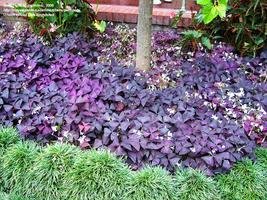 Oxalis triangularis 'Atropurpurea' is a favorite of mine for obvious reasons
Oxalis triangularis 'Atropurpurea' is a favorite of mine for obvious reasons
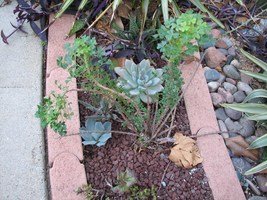
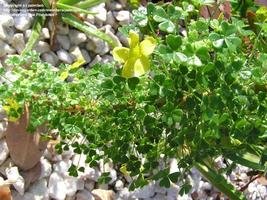
Oxalis gigantea, a succulent species, in my garden- definitely not a weed (to me) and not all that easy to grow all the time
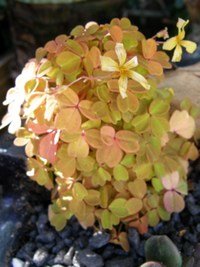

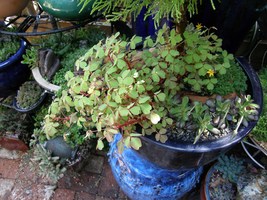
This Oxalis 'Sunshine Velvet' is another one I have purposely added to the garden, though unless in full sun turns a disappointing green (last photo)... and starts to look far too much like Oxalis stricta (middle photos thanks to Kell)
I was pleased to see that some garden pests prefer eating this plant over many others I grow, but predation by insects and slugs does little to stifle the progress of this pesky plant as it invades every nook and cranny of my yard and plant collection. Even Bermuda grass, my old number one enemy, has been overtaken by this dinky little invader.
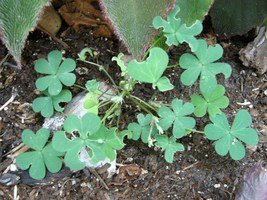
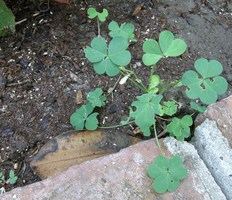 Several nibbled but happy weeds
Several nibbled but happy weeds
Oxalis spreads by about every means imaginable making it quite adapted for its primary goal- existing everywhere as an annoying weed. It grows rapidly from seed, apparently becoming a reproductive adult in just 2 seconds after germination... or so it seems. If incompletely removed, it will regrow from its roots. If left in situ long enough it will start spreading by ‘rhizomes' or stolons. Often an entire pot full of oxalis is simply one plant interconnected by these fragile root extensions... sadly removing one rarely pulls up the rest of the family members as these stolons are weak and snap too easily. Seed pods that fall off while weeding rapidly mature and release somewhere between 100 to a gazillion seeds. If allowed to dry out, these seed pods then burst sending barely visible red-brown seeds up to 4' away in all directions. All these seeds need to germinate is oxygen, which is ubiquitous in our atmosphere (so no worries if you are growing plants in outer space or a vacuum, oxalis will not grow there).
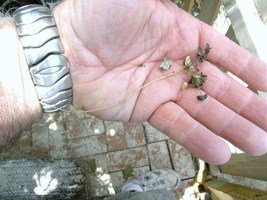
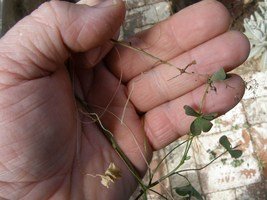

Oxalis stricta showing simple, skinny root- doesn't look like much; Plant with stolons connected to other plants; decapitated top part of plant sans roots, showing leaves and flower

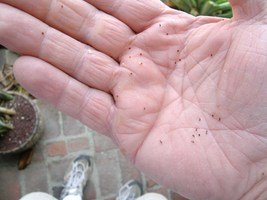
Section of plant with seed pods; these dinky red-brown seeds just 'appeared' in my hand while weeding (seed pods exploded)
Comments about this weed on the web include one that states at least it is an easy weed to pull up. Perhaps in moist soils, but where I live the soils are clay and pulling up an oxalis from dried clay soil without having the root snap off is a challenge. However am not overly concerned with oxalis in the ground, and it seems to be a minor pest in areas of the garden with native clay soils. It exists, but most plants in the ground in my garden are much larger than Oxalis stricta and seem unconcerned by its presence. Additionally I can barely notice it in such areas and its presence is only background ‘noise'.
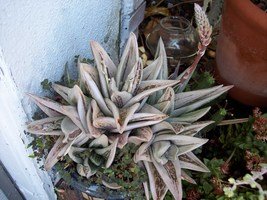
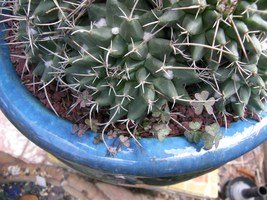
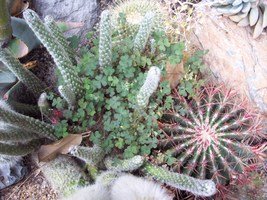
Oxalis stricta in Gasteraloe pot where it super hard to remove... and this plant will be impossible to get back into this pot once removed; Oxalis growing next to a large Mammillaria where there is simply no room for my fingers to get in there and grab the weeds; YOU try to weed this garden in the third photo! OUCH!
But in a succulent pot with relatively dry, nutrient deficient soil, this ugly little scraggly weed rarely looks good but seems to grow tenaciously everywhere. And pulling it out of these pots without snapping a root is much harder still. The reasons for this is most of these pots have little room left to actually grab the oxalis plant at or below ground level with my fat fingers. Grabbing the plant above ground level or anywhere there isn't root itself invariably leaves one with a decapitated specimen, with all the parts sufficient for making an entire new plant in no time still safe within the soil. This is particularly a problem in pots with cactus where the oxalis plants, ‘sensing' the safe proximity of the cactus spines (Ok, I know it can't possibly ‘know' this... but it sure seems to), grows right next to these plants making digital manipulation of the Oxalis roots a painful or impossible procedure. And if that weren't enough of a problem, the plant then grows like a trellised vine, winding itself flat against the surface of the cactus in and out of the spines making extraction a very tedious and difficult (as well as potentially painful) experience. A single Oxalis stricta can eventually cover an entire spherical or columnar cactus up to 2' above ground level.
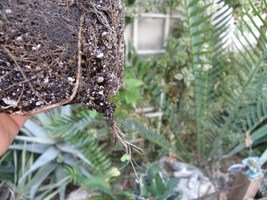 Shot of roots in pots (Oxalis hanging down, and pot removed)
Shot of roots in pots (Oxalis hanging down, and pot removed)
I can't say this actually always harms the plants directly, but it is incredibly unsightly. However, this encapsulating of cacti and some other succulents does tend to trap moisture against these plants creating a potential atmosphere in which rot can easily take place- so these annoying weeds can become killing weeds in some instances. And in some pots where seemingly hundreds, if not billions, of individual oxalis are growing in compact masses, the primary and intended occupant can show obvious signs of stress from the dehydration caused by the thirsty Oxalis roots, and probably signs of mineral deficiency as well (signs which I am not educated enough to notice or discern from dehydration probably). I have lost several plants to Oxalis invasion.
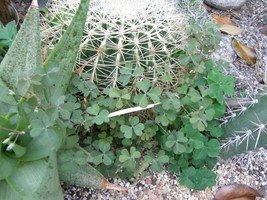
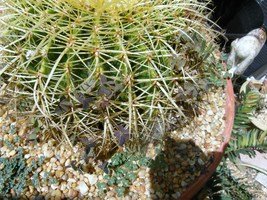

Cacti with clinging Oxalis growing in and out of spines; or plants show up wedged between a rock and a hard place
So how does one get rid of this tenacious beast? The first and most obvious solution was to avoid getting plants infested with oxalis, but this quickly proved to either be impossible or unhelpful. All pots eventually end up with this weed in them once they enter my property whether they had to begin with or not.
So the next obvious step, to me, was to kill each and every oxalis. You can probably guess how that has turned out. My first (and only) resort was to grab the omnipresent Round Up spray bottle that has so uselessly aided in my inability to eradicate other garden pests like morning glory, ivy and Bermuda grass in the past (though eventually it does work against Bermuda grass if one has unending persistence). It was soon after that I discovered, to my dismay, that Round Up is also an effective killer of cactus and succulents (at least some of them- the ones with thicker or waxier skins seem to be moderately resistant). It was after this suboptimal experience that I learned many succulents actually absorb water through their ‘skins' readily as means of acquiring moisture... this of course means that those plants also readily absorb Round Up as well. Sigh. I had assumed that much larger organisms would have a higher tolerance for Round up... and for the most part that is true. But I had also assumed that succulents were designed to keep water in/ keep water out as a water-preserving strategy. That is only partly true. Some do... and some of my now dead plants obvious do not (did not). I still use Round up on Oxalis with a fine, carefully directed spray, as it does kill individual plants fairly effectively, though in the long run this risky method of eradication has not proved successful in complete remission of my Oxalis infestation. I have not tried the more acutely toxic herbicides after my negative experiences with Round Up as I am concerned they will just kill of my favorite succulents even faster. Oxalis X is a recommended brand of ammonium thiosulfate that is supposed to be highly toxic to Oxalis... but I cannot find it at the local Home Depot, nor am I that intent on trying it out on some of the rarer species of succulents.



My 'go to': Round Up; product in second photo is same as in 'Oxalis X'; another herbicide commonly sold in nurseries (haven't tried these second two)



shot of various herbicides at my local nursery; these two products are emergent toxins and might actually be safe for most succulents- you try them and tell me, OK?
From reading about oxalis eradication on the internet, the preferred method that has shown relatively good success is mulching with something that keeps out all light and oxygen- like black plastic or newspaper. This of course is simply not possible with succulents as such mulching techniques would quickly result in the rotting of the plant. Nor is it even practical in pots or gardens crammed packed with spiny plants. I do put top dressing just about everywhere, in the forms of various types and sizes of rock or sand. However Oxalis has no obvious difficulties growing in this situation... in fact, it seems to prefer it.
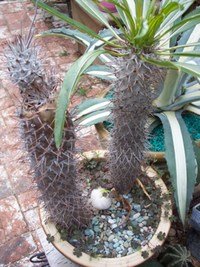 Oxalis stricta growing happily in Pachypodium pot with plenty of stone mulch
Oxalis stricta growing happily in Pachypodium pot with plenty of stone mulch
The next method of Oxalis removal tried, at least from smaller pots with cacti and succulents in them, was weeding with tweezers and forceps. This takes more patience than I can normally muster, but it has helped keep the weeds down to a ‘manageable' number in many of my more prized pots. But it is frustrating trying to extract a heavily wound oxalis vine from a densely spined cactus with a cheap pair of forceps (hard to find ‘expensive' high-quality forceps the size needed for garden use, and it is doubtful they would be all that more useful if I could). This is the method I currently use when I want to show a certain plant and can't use the following method described in the subsequent paragraph because most shows don't want recently potted plants entered in their shows (most have a 6 month or older potting date, though I am not certain how they would ever really know how long one's plant was in a certain pot).
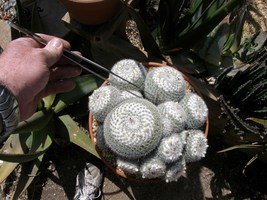 shot of forceps I use, and a Mammillaria that has been 'visibly cleared' of Oxalis (not for long!)
shot of forceps I use, and a Mammillaria that has been 'visibly cleared' of Oxalis (not for long!)
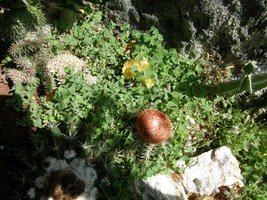
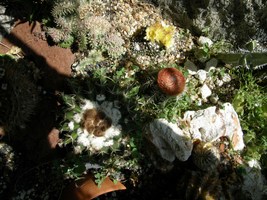 Before picking with tweezers and about 1/2 hour later.. sigh
Before picking with tweezers and about 1/2 hour later.. sigh
Removing the plant from the pot and then all the infected soil, cleaning off the roots and hosing off the plant to get rid of any evidence of the oxalis molecules is really the ‘preferred' method of getting this plant out of a pot. I have done this on a number of occasions and it works, though it is of course only a temporary fix as somehow a seed or two from a neighboring infested pot fly into every other pot in the vicinity eventually over the period of a year and the problem resumes. This repotting procedure is very time consuming and requires one to have a lot of extra soil about. When one has nicely staged plants, this is really a pain as one can rarely reachieve the same exact staging one had before everything was dumped out onto the potting bench. And this method is impractical for huge cacti or in planter boxes crammed packed with deadly spiny cacti and other succulents (as almost all my planter boxes are).
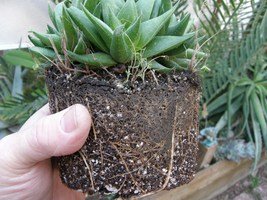 plant sans pot about to have all th soil and Oxalis roots removed
plant sans pot about to have all th soil and Oxalis roots removed
The last method that I have accidentally learned to be moderately effective, though only in terms of not having visible living weed material, is desiccation. Many of my succulents are amazingly drought tolerant, though most appreciate regular water and look best if I give it to them. However, since I am not always that attentive to every individual plant, I have on occasion (am embarrassed to say how often) forgotten to water certain individuals for, say 6-12 months at a time (at which point the rains do it for me). Even as tough as Oxalis stricta is, it cannot live in the complete and total absences of moisture. And eventually these annoying plants will dry up an die, leaving only the gasping succulent behind. But just one watering and the Oxalis is back... oh well.
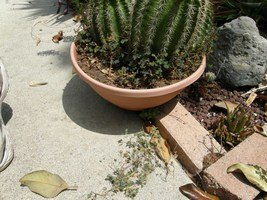 good candidate for dessication- this cactus will tolerate many months without water
good candidate for dessication- this cactus will tolerate many months without water
So what is the ultimate answer? Well, I am trying now to learn to just live with Oxalis stricta and accept the simpler methods involving ripping off what I can see and ignoring what I can't for now. This at least keeps some of the garden areas looking moderately tidy. But there is no ultimate answer unless one has sufficient funds to hire someone else to weed the garden all day long. Wouldn't that be nice!!??
Cactus/Succulent is turning black and soft
Simple Ways On How To Make The Most Out Of Plumbing
Dealing With One Of The Worlds Most Stubborn Pests: Bed Bugs
Gardening has become one of the most popular hobbies!
There Is No Much Difference In The Real Christmas Tree And The Artificial Christmas Tree
My grafted cactus and the cutting of the host plant
Small cactus and succulent assortment SOS!
My cactus is shriveled and black at the bottom
Landscape Gardening And The Benefits One Receives
Door knob and hinges the most overlooked part of your home décor
The Decimator, The Best And Most Effective Alternative To Nylon Brush Cutters.
Copyright © www.100flowers.win Botanic Garden All Rights Reserved